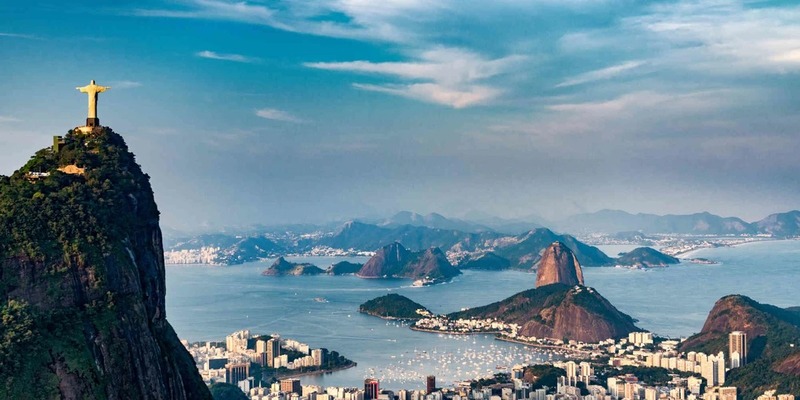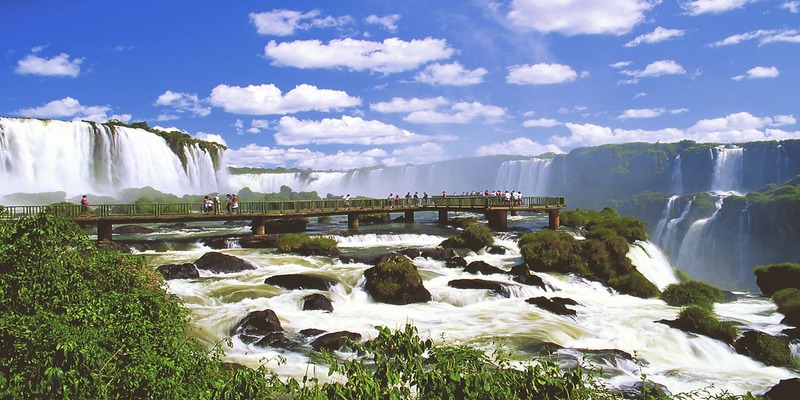Brazil, the largest South American country, covers about half of the continent. Almost everything is located in the tropics, with enormous swaths of tropical rainforest teeming with rare and fascinating flora and fauna.
The country's interior is rich in mineral resources, and golden sand beaches border its 4600 miles of the Atlantic coast. From the 1500s until 1822, Brazil was governed by the Portuguese. Because Portuguese is the official language, it is not surprising to see Portuguese influences in Brazil's colonial architecture and decorative arts.
Christ the Redeemer

Christ the Redeemer, one of Brazil's most recognizable landmarks and Rio's top tourist attraction, was built between 1931 and 1932 to a final height of 98 feet and 92 feet at the widest point of his spread arms.
Paul Landowski, a Polish-French sculptor, and Heitor da Silva Costa, an engineer from Brazil, created a piece out of reinforced concrete covered in a mosaic of thousands of soapstone tiles in a triangle shape.
The monument is placed on a platform at the mountain's peak upon a square stone pedestal that measures around 26 feet tall. The foundation has a chapel, which is frequently used for ceremonies.
The Waterfalls of the Iguazu River

At the tripoint of Brazil, Paraguay, and Argentina, the Iguaçu River flows through the rocky, uneven territory for almost ten miles until it joins the Parana River. From there, it thunders into a valley in a semicircular chain of 247 erratic waterfalls.
Right before the falls, the river narrows to one-fourth of its normal width, increasing the intensity of the water's rush. Since the falls range across a large region, it is impossible to observe them all at once. However, the Brazilian side provides the best panoramic view.
Copacabana Beach, Rio de Janeiro
Copacabana, the chicest neighbourhood in Rio de Janeiro, is situated on a tiny peninsula between the mountains and the ocean. Its namesake avenue, Nossa Senhora de Copacabana, leads directly to the city's most beautiful stretch of beach, which stretches for 2.5 miles.
You'll find everything from high-rise hotels and apartments to cafes, boutiques, nightclubs, restaurants, theatres, bars with live music, street fairs, and pubs along the water's edge. It's a busy, raucous, and traditional area with a dash of Brazilian spirit.
Rio de Janeiro, Carnaval
The City of Rio de Janeiro One of Brazil's most popular draws is Carnaval, which is considered the "mother," "mecca," and "king" of all carnivals. Before the start of Lent, Rio de Janeiro had the world's largest party, with over five million guests from all over the globe.
Carnaval is an extravaganza in terms of the amount of colour, noise, activity, and excitement it contains. This is not a random rowdy block party but a professionally staged spectacle. The Sambódromo is a special stadium where the best dancers and musicians from the many samba schools compete and show off their goods during Rio Carnaval's most famous event, the Samba Parade.
Ipanema
Ipanema Beach, located between Arpoador and Leblon beaches, is a popular tourist destination and one of the most affluent neighbourhoods in Rio de Janeiro. The area's reputation as Rio's "Little Paris" stems from its abundance of cutting-edge cultural institutions such as art galleries, bookshops, movie theatres, hotels, restaurants, and cafes.
Waves demarcate the beach from the pavement, much as they do on the expansive promenade at Copacabana. On Sundays, there is a plethora of activities for families to enjoy in Brazil, like the Feira de Artesanato de Ipanema and an antique market at Praça de Quentaland, offering anything from wooden toys to swizzle sticks topped with parrots.
Salvador Pelourinho
The Pelourinho district of Salvador, the ancient colonial capital of Brazil, is the city's historical and cultural hub. Salvador's colourful buildings and cobblestone alleys are a magnificent representation of blending of African, indigenous, and European cultures over the years.
This historic district was designated as a UNESCO World Heritage site with the best collection of colonial structures in South America. Built at a time when Brazil was the source of Portugal's riches, the city of Salvador's most spectacular churches and monasteries were lavishly adorned with gold.
Sao Paulo's Art Museums
The museums and galleries of Sao Paulo have some of Latin America's finest art collections, and the structures that host them are themselves works of art. The Museu de Arte, MASP is widely regarded as Brazil's finest art museum, housing the continent's most extensive collection of Western art, including notable pieces from Classical antiquity, the Renaissance, and the Baroque period, as well as numerous pieces by Brazilian and other Latin American artists.
Designed by Italian architect Lina Bo Bardi, the museum is a notable example of Modernist architecture. Its brilliant red concrete construction gives the building prominence above ground, setting it out from the surrounding, more subdued high-rises.

The Ultimate Iceland Travel Guide

Where To Find The Finest Local Christmas Gifts In Austin

Spend Your 2023 Honeymoon in The Island Paradise Of The Seychelles.

Brazil's Seven Must-Visit Attractions

Official Adirondacks Travel Guide – Best Things To Do (2022)

The Ultimate Budget Travel Guide to Boise, Idaho

BESTLIST: A New Search Engine Will Help You Plan Better Trips

Cheap exotic vacations for couples

A Comprehensive 8-Day Travel Plan From Singapore to Malaysia

The Best Travel Advice for Your Next Trip to Belgium

Where To Find Festive Spirit At Europe's Christmas Markets
